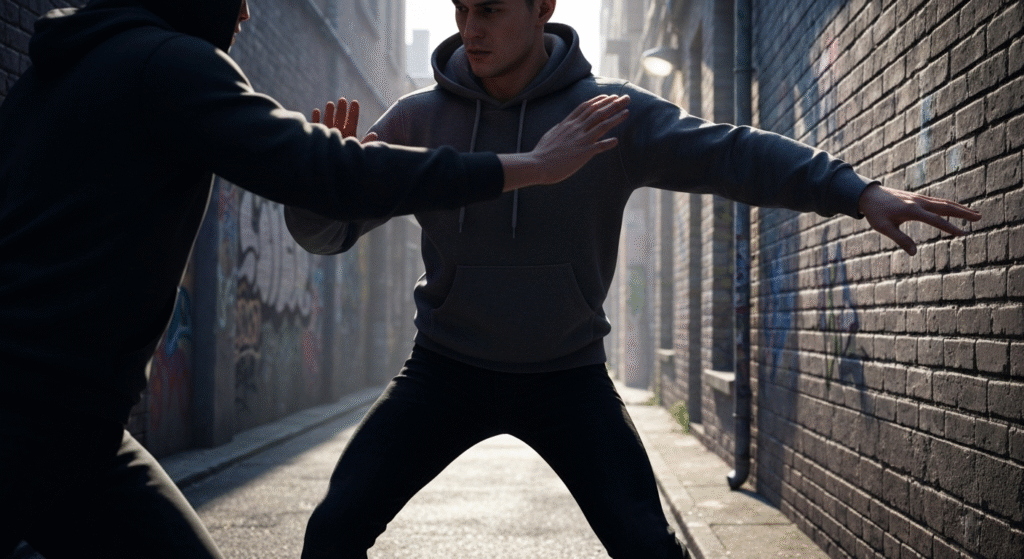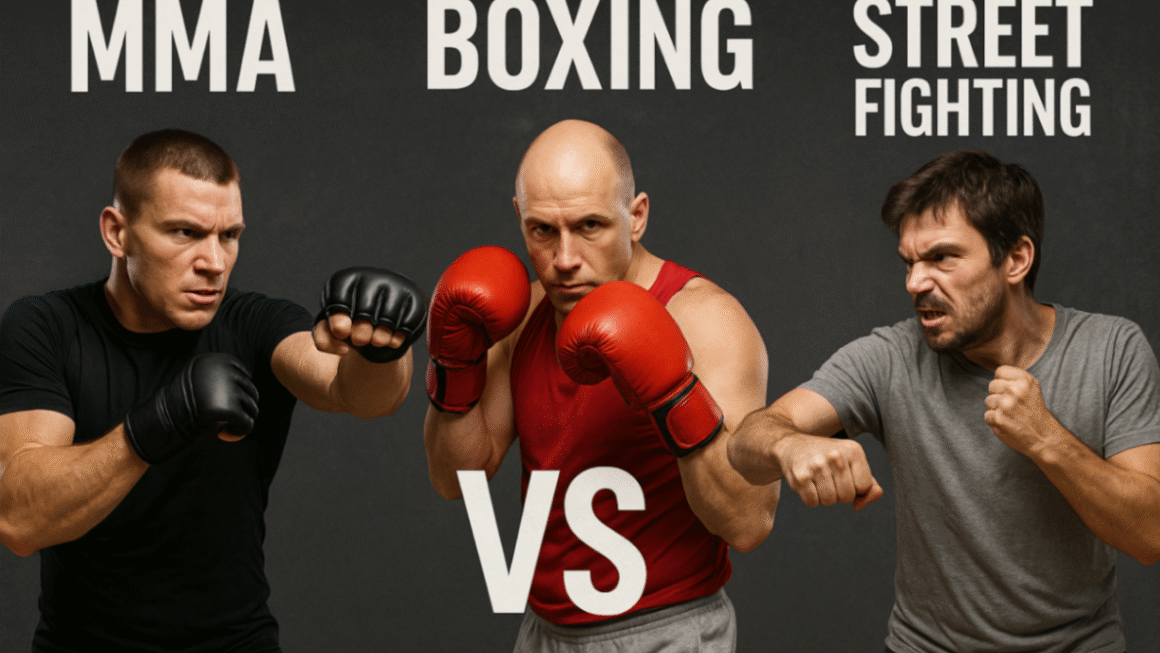Key Highlights
- Striking techniques play a crucial role in both MMA and street fights, with effectiveness often relying on simplicity and speed.
- Key strikes like the jab, cross, and low kick have proven to deliver powerful results in various combat sports scenarios.
- Defensive tactics and awareness of surroundings are vital components in adapting MMA techniques for real-world altercations.
- Understanding the differences in striking combinations between controlled environments and street fights can enhance self-defense strategies.
- Utilizing mixed martial arts training can equip individuals with versatile tools for overcoming street attacks and enhancing personal safety.
Introduction
In the dynamic world of combat sports, effective striking techniques shape the outcome of both MMA encounters and street fights. Understanding the nuances of various martial arts and how they translate into real-world scenarios is crucial for success. Whether relying on powerful punches or strategic kicks, every fighter needs to develop a keen sense of timing and awareness. Prioritizing efficient movements will enhance one’s fight IQ, allowing martial artists to adapt seamlessly to different environments, be it a controlled ring or a chaotic street setting.
Most Effective Striking Techniques in MMA and Street Fights

Various striking techniques wielded in mixed martial arts and street fights highlight the integral skills required for effective combat. Techniques like the jab serve as a quick, direct attack for range control, while the cross delivers potent knockout potential. Short-range strikes such as the lead hook and elbow strike prove invaluable in clinch situations. Additionally, disruptive low kicks and powerful knee strikes can redirect an opponent’s movements, showcasing the importance of adaptability and precision in both controlled and spontaneous environments.
1. Jab – Fast, Direct Attack for Range Control
A jab serves as a fundamental tool in both MMA and street fights, functioning as a fast, direct attack that establishes range control. This quick strike, delivered from a proper stance, allows martial artists to disrupt an opponent’s rhythm while gauging distance. Perfecting the jab requires hours of practice and develops muscle memory, enhancing fight IQ. By utilizing head movement and keeping the opponent at bay, the jab can set up more powerful strikes, demonstrating its versatility in striking techniques.
2. Cross – Powerful Straight Punch for Knockout Potential
The cross delivers significant knockout potential, serving as a crucial weapon in both MMA and street fights. This powerful straight punch, thrown from the rear hand, utilizes the fighter’s body mechanics and weight transfer to generate immense force. Timing and precision enhance its effectiveness, allowing martial artists to exploit openings and capitalize on an opponent’s movement. Training the cross requires focus on proper stance, head movement, and muscle memory, enabling a fighter to employ this strike decisively when it counts most. Specific karate techniques, such as the straight punch (gyaku-zuki), are highly effective and have been successfully adapted for both MMA and street fights, demonstrating how traditional martial arts skills can translate into real-world combat scenarios.
3. Lead Hook – Versatile Short-Range Strike
An effective lead hook serves as a versatile short-range strike in both MMA and street fighting. This technique utilizes rotational movement, allowing martial artists to generate power from their core. The lead hook can disrupt an opponent’s rhythm and create openings for follow-up attacks. Its adaptability makes it a favored choice in close quarters, whether combined with defensive tactics or thrown as a standalone strike. Mastering this art form requires hours of practice, emphasizing proper stance and timing for maximum impact.
4. Rear Uppercut – Close Quarters Power Punch
In close-quarter combat, the rear uppercut stands out as a formidable striking technique. This power punch harnesses the body’s kinetic energy, allowing martial artists to deliver devastating force upwards, targeting the opponent’s chin or jaw. Its effectiveness lies in surprise, often opening avenues for follow-up strikes. Practicing this move cultivates muscle memory, enabling fighters to execute it seamlessly amidst incoming attacks. When employing the rear uppercut, a proper stance enhances stability, while head movement ensures evasion of counterattacks.
5. Overhand Right – High Impact Surprise Attack
A well-executed overhand right can catch an opponent off-guard, showcasing the importance of timing and angle in striking techniques. This punch, often seen in various martial arts, combines speed and power, delivering significant impact, especially when an opponent is focused on a different target. Effective use of head movement adds an element of surprise, turning a simple technique into a decisive action. Practicing this punch not only refines muscle memory but also enhances your overall fight IQ for both MMA and street fighting scenarios.
6. Low Kick – Disruptive Leg Targeting
Low kicks serve as a strategic tool in both MMA and street fighting, disrupting an opponent’s balance and mobility. By targeting the opponent’s thigh with precise strikes, fighters can effectively diminish their speed and ability to execute powerful kicks. As articulated in various martial arts, including Muay Thai, the use of low kicks requires keen awareness of the opponent’s movements and proper stance to execute. This economical striking technique can change the dynamics of a fight, making it a valuable asset in combat sports.
7. Front Kick – Defensive and Offensive Utility
A front kick serves as a versatile tool within both self-defense and competitive striking scenarios. This technique, rooted in martial arts like Muay Thai, effectively creates distance and disrupts an opponent’s balance. Utilizing the ball of your foot, it can deliver a powerful blow while facilitating swift retreats and defensive moves. Practicing this technique develops muscle memory, allowing martial artists to respond instinctively to incoming attacks. Mastering the front kick enhances overall fight IQ, providing decisive advantages in various combat sports contexts.
8. Elbow Strike – Devastating in Clinch and Close Range
In the chaos of close-quarter combat, an elbow strike can turn the tides swiftly. This technique, favored in muay thai and modern MMA, utilizes the hard bone of the elbow as a powerful weapon, effectively targeting an opponent’s head or body. Muscle memory plays a crucial role, enabling martial artists to execute this move flawlessly under pressure. The elbow strike excels when grappling, particularly in clinches, allowing for decisive action against incoming attacks, showcasing the art’s effectiveness and devastating potential.
9. Knee Strike – Effective for Breaking Guard and in Clinch
Striking with the knee is a highly effective technique, especially when immobilized in close quarters. Leveraging the power of your legs, this strike can break through an opponent’s guard while maintaining balance. Precision in targeting the opponent’s body or head amplifies its effectiveness, often leading to decisive outcomes in combat scenarios. Mastery of knee strikes enhances your fight IQ, allowing a martial artist to transition smoothly between grappling and striking disciplines, thus showcasing a deeper understanding of various martial arts approaches.
10. Palm Strike – Safe and Reliable for Street Defense
Utilizing the palm strike effectively can serve as a critical defensive maneuver in unexpected street fight scenarios. This technique allows for substantial impact while reducing the risk of injury to the hand, a common concern for many martial artists. By targeting sensitive areas like the bridge of the nose, attackers can leverage rapid acceleration while maintaining a stable posture. Mastery of this striking technique requires consistent practice, enhancing muscle memory and ensuring responsiveness during high-pressure situations, ultimately leading to better overall fight IQ.
Key Differences Between MMA and Street Fight Striking

Understanding the disparities in striking between MMA and street fights is crucial for any martial artist or self-defense practitioner. In contrast to the structured environment of MMA—with its rules, protective gear, and awareness of grappling techniques—street fights often involve unregulated chaos where anything goes. The focus in mixed martial arts is on controlled combinations and effective techniques, whereas street encounters may require spontaneous, simpler attacks, emphasizing economy of motion and decisiveness to navigate the unpredictability of real-world confrontations.
Rules and Protective Gear vs. No Rules Environment
Adhering to established rules and protective gear shapes the dynamics of MMA, promoting safety while showcasing skillful striking techniques. Fighters engage with gloves, headgear, and oftentimes shin guards, allowing them to execute techniques like knee strikes and low kicks with reduced injury risk. In contrast, a no-rules environment found in street fights often leads to unpredictable and raw encounters, where fighters must rely on their instincts and muscle memory. The absence of regulations means that effective techniques like elbow strikes and overhand rights can quickly become decisive actions in chaotic confrontations.
Controlled Combinations vs. Spontaneous, Simple Attacks
Strategic execution in both MMA and street fights hinges on the ability to differentiate between controlled combinations and spontaneous, simple attacks. In a structured environment like modern MMA, fighters employ combinations developed through hours of practice, utilizing economy of motion for maximum efficiency. Conversely, street fighting often necessitates instinctual responses, relying on muscle memory and basic techniques. This unpredictability can favor those who adapt quickly, utilizing powerful strikes, such as knee or elbow strikes, that capitalize on the chaotic nature of unregulated encounters.
Adapting Striking Techniques for Self-Defense Scenarios

In high-pressure situations, prioritizing simplicity and speed is essential for effective self-defense. Techniques such as the jab and front kick allow for quick engagements, creating distance while maintaining a proper stance. Utilizing muscle memory, practitioners can respond instinctively to incoming attacks without overthinking. Awareness of surroundings enhances the ability to adapt strikes based on the dynamics of the confrontation, allowing for decisive action when faced with unpredictable street fights. Emphasizing these elements increases effectiveness, regardless of body type or experience level.
Prioritizing Simplicity and Speed Under Pressure
Effective striking in high-pressure situations demands a focus on simplicity and speed. Complex combinations often lead to hesitation, which can be costly during street fights or MMA bouts. Training should emphasize economy of motion, helping martial artists execute techniques with minimal effort while maximizing impact. Practicing drills that enhance muscle memory ensures that responses to incoming attacks become instinctual, allowing fighters to react swiftly and decisively. Streamlining techniques not only increases the likelihood of success but also promotes better overall fight IQ.
Using Surroundings and Maintaining Awareness
Incorporating surroundings into strategy can significantly enhance effectiveness in combat situations. Assessing the environment helps to identify potential advantages, such as walls for leverage or objects to use for defense. Maintaining awareness of your opponent’s movements, coupled with a keen perception of your surroundings, allows for decisive action, honing your fight IQ. This adaptability is crucial, whether executing striking techniques or engaging in grappling maneuvers. Mastering this aspect can be the difference between success and failure in high-pressure scenarios.
Conclusion
Effective striking techniques are fundamental across martial arts, whether in the ring or on the street. Mastery of these techniques requires dedication, practice, and a keen understanding of both offensive and defensive movements. Incorporating principles from disciplines like Muay Thai and Krav Maga enhances one’s ability to respond to varied combat scenarios. By recognizing the nuances and adapting strategies as needed, martial artists can ensure their preparedness for any striking situation, maximizing their potential for success in both MMA and self-defense encounters.
Frequently Asked Questions
Which martial arts striking techniques are safest to use in a street fight?
In a street fight, techniques like the palm strike and knee strike are often considered safer due to their effectiveness and lower risk of injury to the user. Prioritizing simplicity and speed with these techniques can enhance self-defense outcomes while minimizing personal harm.
How can I modify MMA striking for unpredictable street fight situations?
To adapt MMA striking for unpredictable street fights, focus on simplicity and speed. Prioritize fundamental techniques like jabs and hooks, maintain awareness of your surroundings, and be ready to react instinctively to sudden changes while using available objects for defense or offense when necessary.
What’s the difference between striking and grappling for self-defense?
Striking focuses on delivering powerful, rapid attacks to incapacitate an opponent from a distance, while grappling emphasizes controlling and subduing an opponent through holds and positional dominance. Both techniques are vital in self-defense, but their applications differ based on the situation.




